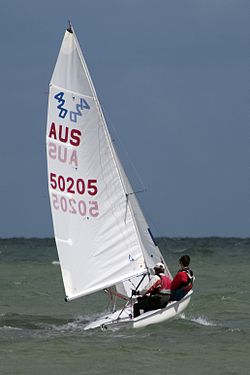420 (dinghy)

Class symbol
|
|

420s under sail
|
|
| Designer | Christian Maury |
|---|---|
| Year | 1959 |
| Design | One-Design |
| Role | Youth trainer, racing |
| Crew | 2 |
| Draft | 0.965 metres (3 ft 2.0 in) |
| Trapeze | Single |
| Type | Monohull |
| Construction | GRP |
| Hull weight | 80 kilograms (180 lb) |
| LOA | 4.20 metres (13 ft 9 in) |
| Beam | 1.63 metres (5 ft 4 in) |
| Keel/Board Type | Centerboard |
| Rig Type | Bermuda |
| Mast Length | 6.26 metres (20 ft 6 in) |
| Mainsail area | 7.45 square metres (80.2 sq ft) |
| Jib / Genoa area | 2.8 square metres (30 sq ft) |
| Spinnaker area | 8.83 square metres (95.0 sq ft) |
| Upwind Sail Area | 10.25 square metres (110.3 sq ft) |
| D-PN | 86.3 |
| RYA PN | 1087 |
| Class is a member of World Sailing | |
The International 420 Class Dinghy (not to be confused with the Club 420) is a double-handed (2 crew) monohull planing dinghy with centreboard, bermuda rig and center sheeting. The name describes the overall length of the boat in centimeters (the boat is exactly 4.2 meters long). The hull is fiberglass with internal buoyancy tanks. The 420 is equipped with spinnaker and optional trapeze, making teamwork necessary to sail it well. It has a large sail-area-to-weight ratio, and is designed to plane easily. It can be rigged to be sailed single-handed.
The 420 was designed specifically to be easier to handle than its larger higher-performance cousin, the 470. The 420 was designed by French engineer Christian Maury, as a stepping-stone for club and youth sailing to the 470. The 420 is an International class recognized by the International Sailing Federation.
A derivative of the 420 called the Club 420 is popular in the North America. This class is not recognised by International Sailing Federation or the International 420 Class Association and cannot be used at class events. The boats are very similar in appearance but the Club 420 is slightly stronger, heavier and less refined.
The International 420 was designed by Christian Maury, after a specification drawn by Aristide Lehoerrff and Pierre Latxague, chief sailing instructors of the Centerport sailing school South-West France near St Jean de Luz. It was built at first by French industrialist Lucien Lanaverre, a former cooper for the Bordeaux wine industry, who had converted to the then new industry of GRP polyester moulding in the 1960s as an inexpensive general purpose two sail, transom sheeted, non-trapeze dinghy, with modest easily handled sail plan. The class developed rapidly in France, being adopted nationally as a youth trainer for the larger Olympic class International 470 which was designed by André Cornu. By the late 1960s the class was adopted by a few UK university sailing clubs for training and team racing. It has the famous Bermuda rig.
...
Wikipedia
